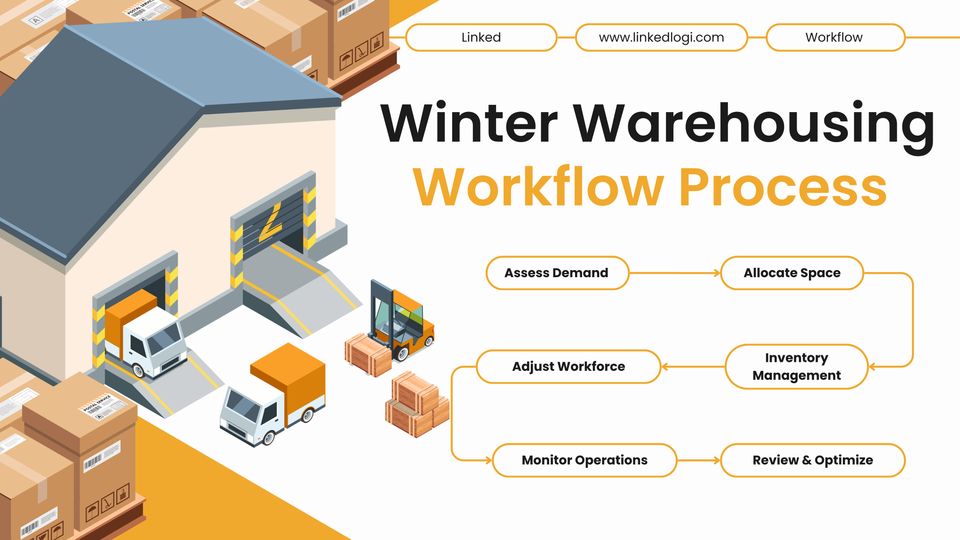Cold Weather, Hot Strategy: Winterizing Import-Export Operations for Global Efficiency

Global trade doesn’t pause for weather. Yet, every winter, import-export operations around the world face slowdowns due to temperature extremes, transport delays, and higher costs. The key to staying competitive lies in smart winterization—planning, optimizing, and securing trade routes before the frost sets in.
At Linkedlogi, we specialize in helping global traders prepare for winter without losing speed, efficiency, or profitability.
The Hidden Costs of Winter Trade Disruptions
When shipping containers freeze, or ports delay unloading due to storms, it’s not just time that’s lost—it’s credibility and capital.
Studies suggest that weather-related delays cost the logistics industry nearly $3.5 billion annually in lost productivity.
Winter affects import-export chains in the following ways:
- Maritime Delays: Sea ice formation and storms reduce ship speeds or halt departures.
- Customs Bottlenecks: Delayed paperwork during holidays slows clearances.
- Temperature Risks: Electronics, beverages, and chemicals can freeze or degrade.
- Insurance Costs: Winter increases cargo insurance premiums.
- Reduced Workforce: Shorter daylight hours and safety risks limit port operations.
Prepared businesses turn these seasonal constraints into strategic advantages.
1. Port and Route Optimization
Winter makes certain ports inefficient due to ice accumulation or high winds.
Smart exporters plan seasonal rerouting—leveraging southern or equatorial ports.
Digital tools like Linkedlogi’s Route Intelligence System help traders:
- Compare seasonal port reliability.
- Evaluate demurrage risks.
- Optimize vessel schedules with real-time weather feeds.
2. Container Insulation and Cargo Protection
Temperature-sensitive goods require extra attention during winter.
Best practices include:
- Using thermal blankets and cargo covers.
- Installing smart temperature loggers inside containers.
- Choosing reefer containers with dual power modes.
- Scheduling faster customs clearances for high-risk shipments.
By combining physical protection with digital tracking, exporters ensure goods remain compliant and intact.
3. Coordinating with International Partners
Winter holidays differ globally—Christmas in the West, Lunar New Year in Asia.
Unaligned schedules can lead to shipment gridlocks.
Smart importers/exporters maintain:
- Pre-winter coordination meetings with suppliers and freight forwarders.
- Updated documentation to avoid delays due to missing papers.
- Emergency contact networks for alternate suppliers.
At Linkedlogi, we recommend creating a Winter Operations Calendar mapping every region’s peak slowdown period.
4. Managing Freight Rates and Insurance
Winter often triggers freight surcharges and insurance hikes.
To mitigate costs:
- Lock in long-term contracts before November.
- Consider multimodal transport combinations (e.g., rail + air).
- Review marine insurance clauses for weather exceptions.
- Use Linkedlogi’s freight monitoring dashboard to compare rates dynamically.
Financial foresight is as important as physical readiness.
5. Warehousing and Inventory Strategy
Holding the right inventory at the right location is crucial when routes freeze.
Winter warehousing tips:
- Distribute safety stock across regional hubs.
- Maintain climate-controlled environments.
- Use AI inventory models to predict product turnover.
A decentralized model ensures goods remain accessible even if one route closes temporarily.
6. Leveraging Technology for Transparency
IoT and blockchain solutions are revolutionizing cross-border trade:
- IoT ensures end-to-end cargo visibility.
- Blockchain minimizes customs delays through digital documentation.
- Predictive analytics forecasts port congestion before it occurs.
At Linkedlogi, our approach merges these technologies for seamless visibility—from port to customer.
7. Human Element: Safety and Communication
Don’t overlook your most valuable resource—people.
Winter increases risk for drivers, dock workers, and logistics staff.
Training, safety gear, and clear communication prevent accidents and morale dips.
A motivated team ensures smoother winter transitions than any system can.
8. The Green Angle: Sustainability in Winter Logistics
Winter operations often consume more fuel.
However, by optimizing routing, using electric vehicles, and consolidating loads, logistics providers can cut emissions and costs simultaneously.
Linkedlogi’s analytics help identify where winter energy consumption can be minimized through route redesign or eco-driving techniques.
Conclusion: Winter Is an Opportunity, Not a Setback
Winter doesn’t have to freeze your profits.
It can strengthen your logistics capabilities if approached strategically.
By embracing predictive tools, diversifying routes, and integrating global coordination, businesses can deliver reliably—no matter the temperature outside.
At Linkedlogi, we help brands turn winter challenges into competitive advantages through innovation, foresight, and operational excellence.
